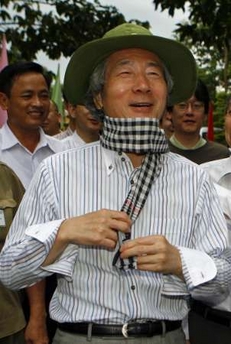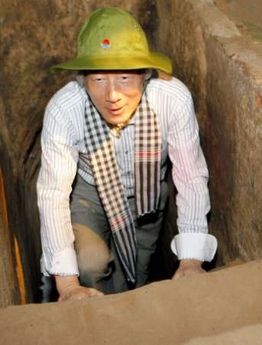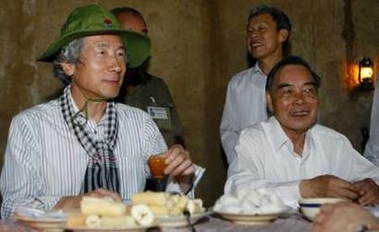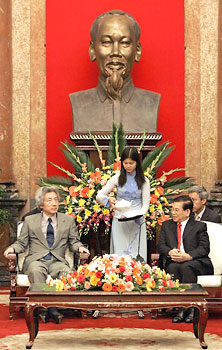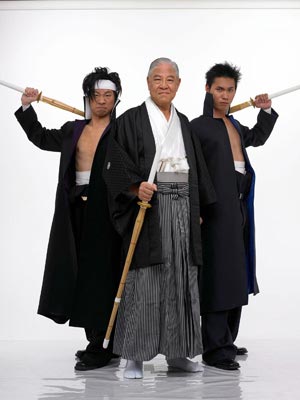Following Adam’s post on the word of the year awards in Japan, I thought I would give a quick rundown on the English version of the list, as determined by the New Oxford American Dictionary. I’ll present the various runners-up in list form, with the word of the year at the end, with each entry followed by my own comments in italics.
- aging in place: the process of growing older while living in one’s own residence, instead of having to move to a new home or community
We’re not off to a very good start here. First of all, this is not a word but a phrase, and not to me a particularly descriptive one at that.
- bacn: email notifications, such as news alerts and social networking updates, that are considered more desirable than unwanted “spam” (coined at PodCamp Pittsburgh in Aug. 2007 and popularized in the blogging community)
Total gibberish. While I agree that we could use a term for this semi-junkmail, a tier below spam, this word just plain sucks. What is this, an acronym? Wikipedia claims that it’s pronounced “bacon,” to imply that it is something better than spam, but still unwanted. Except that bacon is delicious, and I don’t see any reason to spell it wrong. In short- I like the definition, but we need a new word. Maybe 2008.
- cloudware: online applications, such as webmail, powered by massive data storage facilities, also called “cloud servers”
“Cloud computing” is a term I’ve seen for at least a couple of years now, and I agree that “cloudware” is the appropriate word for applications that represent the paradigm of cloud computing.
- colony collapse disorder: a still-unexplained phenomenon resulting in the widespread disappearance of honeybees from beehives, first observed in late 2006
The first one I’ve actually seen before! Both timely and important, and a great example of a term that rose to prominence during 2007. Unfortunately, once again we have a phrase. Try translating it into a nice agglutanive like German, Greek or Chinese and get back to me.
- cougar: an older woman who romantically pursues younger men
Another word I’m familiar with (and yes, I mean the word and not the thing itself.) A good slang term that has clearly cemented itself in the language, but I have no idea how long the term “cougar” has been around or if it rose to particular prominence this year for some reason. Has there been a rash of “cougar attacks” in 2007 that I was unaware of?
- MRAP vehicle: Mine Resistant Ambush Protected vehicle, designed to protect troops from improvised explosive devices (IEDs)
I’ve probably seen this term before, but I can’t swear. While the MRAP has probably existed for a good while, I do see a logic for its rise to prominence this year. On the other hand, has IED been a word of the year before? If not, then clearly that should have taken this slot.
- mumblecore: an independent film movement featuring low-budget production, non-professional actors, and largely improvised dialogue
I think I first saw this term only a couple of months ago. I don’t believe I have actually seen a mumblecore film, but it sounds like the sort of indy film that gives indy film a bad name. Does it deserve to be on the list? Well, whether or not the word existed before 2007, this was certainly the year it made it big, so I’ll give it a pass.
- previvor: a person who has not been diagnosed with a form of cancer but has survived a genetic predisposition for cancer
A word I have certainly seen before, although it bugs me slightly for some reason. While the etymology of “previvor” is clearly based on “survivor,” with an added implication of something not having happened yet- but it still feels slightly muddled to me. For a word created from a simple combination of two highly generic roots (pre- as in before, and vivor- as in “to live”) I feel that it should have a scope of applicability larger than just cancer, but I suppose a word has to start somewhere.
- social graph: the network of one’s friends and connections on social websites such as Facebook and Myspace
Definitely another sign of the times here. I would like this more if a literal, social graph, as in a nice web-form chart, of one’s social network were actually a core feature of these sites. God I hate Myspace.
- tase (or taze): to stun with a Taser (popularized by a Sep. 2007 incident in which a University of Florida student was filmed being stunned by a Taser at a public forum)
Not even a remotely new word-I personally have probably used it for years-and an obvious back-formation of “taser” (lit. “that which tases.”) Despite the lack of newness, the extremely high visibility of tasing incidents this year does give “tase” some extra cachet as a word of the year candidate.
- upcycling: the transformation of waste materials into something more useful or valuable
Not a word I have heard before, but it makes sense and doesn’t particularly bother me.
And the word of the year-
- “Locavore” was coined two years ago by a group of four women in San Francisco who proposed that local residents should try to eat only food grown or produced within a 100-mile radius. Other regional movements have emerged since then, though some groups refer to themselves as “localvores” rather than “locavores.” However it’s spelled, it’s a word to watch.
I have two problems with this one. First of all, I feel that there is something just wrong about a word of the year that I had never heard of previously. This might be ok for a runner-up, but shouldn’t the word of the year be something widespread enough so that a media addict like myself would have at least seen it before? Secondly, a word clearly identified as having been created by a particular group of persons to promote an ideology just feels too manufactured, and not grass-roots authentic enough, to deserve word of the year status. On the plus side, it is etymologically sounds, although “localvore” is a lousy variant.
Comparing this list with the list of Japanese words Adam just showed us, a few things occur to me. First of all, you see a complete lack of words that are associated with, or hyping, any celebrity. Where the Japanese list gives us three celeb catch-phrases “そんなの関係ねぇ,” “どんだけぇ~” and the co-winner “(宮崎を)どげんかせんといかん” as well as one word famous for being the title of what is most likely a shitty self-help book “鈍感力,” and a phrase that describes a particular person, which Adam lovingly translated as “prince of the cheese-eating grin.”
By contrast, Oxford’s list has nothing of the kind. In fact, if you look at the two lists a bit closer you see a fundamentally different, and even oppositional, concept of what “word of the year” represents to Oxford and Jiyukokuminsha (the Japanese publishing company who issued this word of the year list.) The most apparent different between them is that where Oxford’s words were chosen by the professional dictionairians (yes, dictionarian is a real word. Check the 1913 Websters if you don’t believe me.) the Jikokuminsha list was chosen from reader submissions, by an entirely unidentified panel. While the solicitation of reader submitted words is a critical tool of the lexicologist, Oxford has chosen to weed out items that are in fact references to specific people or current events, and most likely not sustainable lexical items.
The second major difference is that while Oxford’s list consists entirely of neologisms (even if not all of them are 100% verified new in 2007), Jikokuminsha also includes the word “pension,” which certainly isn’t a new word. Now, the word “pension” is prefaced by the word “vanished,” but this is still just an ordinary phrase, not a novel formation of any kind, and even worse is a reference to a particular news event and not some ongoing phenomenon.
The Jikokuminsha list does, however, contain several quality words that I think are worthy of inclusion on a list more in the vein of the Oxford one:
- Deceptive food (labeling) 食品偽装 : This is both a major item of concern for 2007, and a new word that will probably be with us for years to come, as food safety and accurate labeling is becoming a matter of increasing concern around the world, both in international trade and domestic markets.
- Internet cafe refugees ネットカフェ難民 : I think the phenomenon was actually reported on several months before the term was coined, but it is an apt and catchy term that will likely stick. The phenomenon has been reported on at least twice on this blog including personal anecdotes, first by Adam just over one year ago and then far more negatively by myself, just a few months ago.
- Mega eater 大食い : I believe this word is actually used as both a noun AND a verb (i.e. a “mega eater” and “to mega-eat.” In general, this term refers to mass food consumption in the contest of competitive eating contests, the most famous of which is the Coney Island hot dog eating contest won year after year by Kobayashi Takeru. According to the Wikipedia article on competitive eating, an appropriate English translation of the term might be “gurgitator” (with the verb form then naturally being “to gurgitate,” but this word lacks the necessary prefix to imply the “mega”ness of the Japanese word.
- Very hot days 猛暑日 : At first I thought that this word lacked the necessary novelty, but on inspection I was wrong. In fact, it turns out this is a technical term used by the Japan Meteorological Agency to describe a day in which the maximum temperature exceeds 35℃. It appears that the word was officially coined in 2006, due to the fact that the number of such days had seen a precipitous rise over the previous decade, and they decided that they needed a word to specifically label days hotter than “truly hot days” (真夏日 – days over 30℃.)
While both lists are naturally attempts to choose words which are iconic of the year 2007 in some way, the Oxford panel attempted to select words that, while they
were newly relevant in 2007, at least have the potential to survive in the future. While there may be a couple of entries that I find questionable in quality (come on, “bacn?” For real?) at least I do not feel like Oxford is trying to make me feel like I need to buy more tabloid magazines or watch the E! channel. But then, both companies are basically trying to stoke interest in their respective dictionaries, and while Jiyikokuminsha’s “Basic Knowledge of Modern Terms” may be pretty good, Oxford publishes the Oxford English Dictionary, which I believe is inarguably the greatest dictionary that exists on the planet, for any language.
Great. Now I just went and reminded myself that not being an active member of a university I don’t have institutional access to the OED Online, and their personal accounts are ludicrously overpriced. Your dictionary may be awesome and all, but for $295/year I think I’ll make do.

